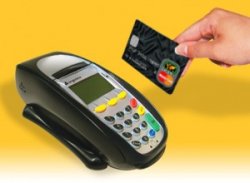EFTPOS keypad layout
It is pretty odd that a calculator and a touch-tone telephone have exactly opposite layouts for their keypads, which have many identical components. The reasons behind the differences are not known for certain, but a few theories exist.
The first theory deals with the telephone's circuitry and tone-recognition hardware. When the touch-tone telephone was being designed in the late 1950s, the calculator and adding-machine designers had already established a layout that had 7, 8 and 9 across the top row. Data-entry professionals, and others who used calculators fairly regularly, were quite adept at navigating these keypads. They could hit the numbers extremely quickly, which was great for data entry, but not so great for dialing a touch-tone phone. The tone-recognition technology could not operate effectively at the speeds at which these specialists could dial the numbers. The telephone designers figured that if they reversed the layout, the dialing speeds would decrease and the tone-recognition would be able to do its job more reliably. This theory has little proof to substantiate it, but it does make sense.
A second theory refers to a study done by Bell Labs in 1960. This study involved testing several different telephone-keypad layouts to find out which was easiest to master. After testing several layouts, including one that used two rows with five numbers each and another that used a circular positioning, it was determined that the three-by-three matrix that had 1, 2 and 3 across the top was the easiest for people to use.
Another theory is based on the layout of a rotary telephone. On a rotary dial, 1 is at the top right and zero is on the bottom. When designing the new touch-tone keypad, putting the 1 on the top-right didn't make much sense, because Western writing is read from left to right. But putting 1 on the top-left, and the subsequent numbers to the right, did make sense. Using that formula, the resulting rows fell into place, with zero getting its own row at the bottom.
All of these theories attempt to explain why telephone and calculator keypads are exact opposites, yet no one theory can be pinpointed as the definitive reason. It is common practice today to use the telephone-keypad layout when designing new products that utilize a keypad, such as Automated Teller Machines.







